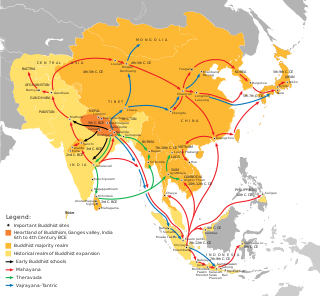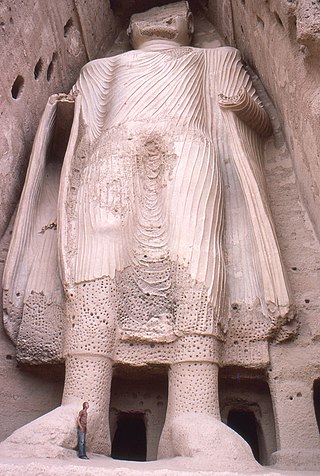
The ancient history of Afghanistan, also referred to as the pre-Islamic period of Afghanistan, dates back to the prehistoric era and the Helmand civilization around 3300–2350 BCE. Archaeological exploration began in Afghanistan in earnest after World War II and proceeded until the late 1970s during the Soviet–Afghan War. Archaeologists and historians suggest that humans were living in Afghanistan at least 50,000 years ago, and that farming communities of the region were among the earliest in the world. Urbanized culture has existed in the land from between 3000 and 2000 BC. Artifacts typical of the Paleolithic, Mesolithic, Neolithic, Bronze, and Iron ages have been found inside Afghanistan.

Bactria, or Bactriana, was an ancient Iranian civilization in Central Asia based in the area south of the Oxus River and north of the mountains of the Hindu Kush, an area within the north of modern Afghanistan. Bactria was strategically located south of Sogdia and the western part of the Pamir Mountains. The extensive mountain ranges acted as protective "walls" on three sides, with the Pamir on the north and the Hindu Kush on south forming a junction with the Karakoram range towards the east.

The Silk Road was a network of Eurasian trade routes active from the second century BCE until the mid-15th century. Spanning over 6,400 km (4,000 mi), it played a central role in facilitating economic, cultural, political, and religious interactions between the Eastern and Western worlds. The name "Silk Road" was first coined in the late 19th century, but some 20th- and 21st-century historians instead prefer the term Silk Routes, on the grounds that it more accurately describes the intricate web of land and sea routes connecting Central, East, South, Southeast, and West Asia as well as East Africa and Southern Europe.

Kanishka I, also known as Kanishka the Great, was an emperor of the Kushan dynasty, under whose reign the empire reached its zenith. He is famous for his military, political, and spiritual achievements. A descendant of Kujula Kadphises, founder of the Kushan empire, Kanishka came to rule an empire extending from Central Asia and Gandhara to Pataliputra on the Gangetic plain. The main capital of his empire was located at Puruṣapura (Peshawar) in Gandhara, with another major capital at Mathura. Coins of Kanishka were found in Tripuri.

The Yuezhi were an ancient people first described in Chinese histories as nomadic pastoralists living in an arid grassland area in the western part of the modern Chinese province of Gansu, during the 1st millennium BC. After a major defeat at the hands of the Xiongnu in 176 BC, the Yuezhi split into two groups migrating in different directions: the Greater Yuezhi and Lesser Yuezhi. This started a complex domino effect that radiated in all directions and, in the process, set the course of history for much of Asia for centuries to come.

The Kushan Empire was a syncretic empire formed by the Yuezhi in the Bactrian territories in the early 1st century. It spread to encompass much of what is now Tajikistan, Uzbekistan, Afghanistan, Pakistan, Eastern Iran and Northern India, at least as far as Saketa and Sarnath, near Varanasi, where inscriptions have been found dating to the era of the Kushan emperor Kanishka the Great.

Greco-Buddhism or Graeco-Buddhism denotes a cultural syncretism between Hellenistic culture and Buddhism developed between the 4th century BC and the 5th century AD in Gandhara, in present-day Pakistan and parts of north-east Afghanistan. While the Greco-Buddhist art shows clear Hellenistic influences, the majority of scholars do not assume a noticeable Greek influence on Gandharan Buddhism beyond the artistic realm.

The Greco-Buddhist art or Gandhara art is the artistic manifestation of Greco-Buddhism, a cultural syncretism between Ancient Greek art and Buddhism. It had mainly evolved in the ancient region of Gandhara, located in the northwestern fringe of the Indian subcontinent.

Vima Kadphises was a Kushan emperor from approximately 113 to 127 CE. According to the Rabatak inscription, he was the son of Vima Takto and the father of Kanishka.
The history of Buddhism can be traced back to the 5th century BCE. Buddhism originated from Ancient India, in and around the ancient Kingdom of Magadha, and is based on the teachings of the renunciate Siddhārtha Gautama. The religion evolved as it spread from the northeastern region of the Indian subcontinent throughout Central, East, and Southeast Asia. At one time or another, it influenced most of Asia.

Mahāyāna Buddhism entered Han China via the Silk Road, beginning in the 1st or 2nd century CE. The first documented translation efforts by Buddhist monks in China were in the 2nd century CE via the Kushan Empire into the Chinese territory bordering the Tarim Basin under Kanishka. These contacts transmitted strands of Sarvastivadan and Tamrashatiya Buddhism throughout the Eastern world.

Many artistic influences transited along the Silk Road, especially through the Central Asia, where Hellenistic, Iranian, Indian and Chinese influence were able to interact. In particular Greco-Buddhist art represent one of the most vivid examples of this interaction. As shown on the 1st century CE Silk Road map, there is no single road but a whole network of long-distance routes: mainly two land routes and one sea route.

Buddhism, a religion founded by Gautama Buddha, first arrived in modern-day Afghanistan through the conquests of Ashoka, the third emperor of the Maurya Empire. Among the earliest notable sites of Buddhist influence in the country is a bilingual mountainside inscription in Greek and Aramaic that dates back to 260 BCE and was found on the rocky outcrop of Chil Zena near Kandahar.

Buddhism in Central Asia mainly existed in Mahayana forms and was historically especially prevalent along the Silk Road. The history of Buddhism in Central Asia is closely related to the Silk Road transmission of Buddhism during the first millennium of the common era. Buddhism dominated in Pre-Islamic Central Asia. It has been argued that the spread of Indian culture and religions, especially Buddhism, as far as Sogdia, corresponded to the rule of the Kidarites over the regions from Sogdia to Gandhara.

The legacy of the Indo-Greeks starts with the formal end of the Indo-Greek Kingdom from the 1st century, as the Greek communities of central Asia and northwestern India lived under the control of the Kushan branch of the Yuezhi, Indo-Scythians and Indo-Parthian Kingdom. The Kushans founded the Kushan Empire, which was to prosper for several centuries. In the south, the Greeks were under the rule of the Scythian Western Kshatrapas.

The Greco-Bactrian Kingdom was a Greek state of the Hellenistic period located in Central Asia. The kingdom was founded by the Seleucid satrap Diodotus I Soter in about 256 BC, and continued to dominate Central Asia until its fall around 120 BC.

Transoxiana or Transoxania is the Latin name for the region and civilization located in lower Central Asia roughly corresponding to modern-day eastern Uzbekistan, western Tajikistan, parts of southern Kazakhstan, parts of Turkmenistan and southern Kyrgyzstan. The name was first coined by Alexander the Great in the 4th century BC when Alexander's troops were able to conquer the region. The region may have had a similar Greek name in the days of Alexander the Great, but the earlier Greek name is no longer known. Geographically, it is the region between the rivers Amu Darya to its south and the Syr Darya to its north.

Gandhāran Buddhism was the Buddhist culture of ancient Gandhāra, which was a major center of Buddhism in the northwestern Indian subcontinent from the 3rd century BCE to approximately 1200 CE. Ancient Gandhāra corresponds to modern day north Pakistan, mainly the Peshawar valley and Potohar plateau as well as Afghanistan's Jalalabad. The region has yielded the Gandhāran Buddhist texts written in Gāndhārī Prakrit the oldest Buddhist manuscripts yet discovered. Gandhāra was also home to a unique Buddhist artistic and architectural culture which blended elements from Indian, Hellenistic, Roman and Parthian art. Buddhist Gandhāra was also influential as the gateway through which Buddhism spread to Central Asia and China.

Toprak-Kala, in modern Karakalpakstan, Uzbekistan, was an ancient palace city and the capital of in Chorasmia in the 2nd/3rd century CE, where wall paintings, coins and archives were discovered. Its history covers a period from the 1st to the 5th century CE. It is part of the "Fifty fortresses oasis" in modern-day Uzbekistan.

Kanishka's Central Asian Campaign refers to the military conquests led by Kanishka, the Kushan emperor, in the 2nd century CE. His expansionist efforts focused on Bactria, a key region in Central Asia, comprising parts of modern-day Afghanistan, Uzbekistan, and Tajikistan. This campaign secured Kushan dominance over strategic Silk Road trade routes and facilitated the cultural and religious spread, notably of Buddhism, throughout Central Asia. It also marked the final decline of Greco-Bactrian and Indo-Scythian powers in the region.

















